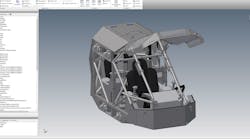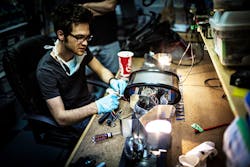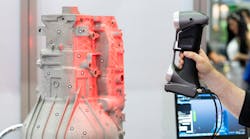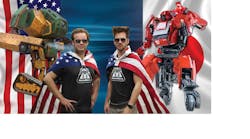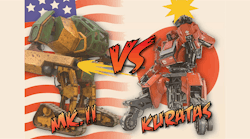[This is an excerpt from our feature "Making the New Industrial Giant."]
MegaBots co-founder Gui Cavalcanti first met former Autodesk CEO Carl Bass there by chance, a relationship that grew in MegaBots’ first and most important partnership. After it was constructed, Autodesk transported the Mk. I — just a cockpit and a cannon — from Boston to Las Vegas to show off at a company event, a trip Mike Geyer, lead evangelist for Autodesk, recalls.
Geyer says the MegaBots co-founders tenacity in the face of logistical changes and broken parts secured the design software giant’s patronage, which included guiding MegaBots design from one-off prototype to a repeatable design others could use to build their own fighting robot using maker spaces to construct this future ultimate fight club.
Whether that happens or not, this robot built at Fortress One proves the potential of a maker space built simply by will power and the never-fading adolescent dreams of two brilliant builders who know their way around a workshop and a sales pitch.
Geyer believes this maker space movement is the start of something huge.
“More and more people are able to now participate in bringing the crazy ideas to reality, and many of those are going to turn out to be terribly disruptive to our traditional manufacturers,” he says.
This new world will emphasize doing while learning, getting your hands dirty as opposed to just scribbling in a notebook.
“The days of the professor at the podium are over,” says Geyer.
Diego Tamburini, Autodesk's design & manufacturing senior industry strategist, agrees that as more makers have better access to digital engineering tools and the professional equipment to bring those to existence, industry can expect great things from unexpected sources.
"You can say that maker spaces help democratize innovation; and more innovators with access to the means of production will result in more innovation," Tamburini says. "I believe that we are reaching an inflection point where ground-breaking innovation will increasingly come from startups, rather than from established companies. If anything, maker spaces have created an unprecedented enthusiasm in manufacturing, which will attract new generations to technology and innovation."
And this crazy robot fight about to go down isn't crazy at all; it's a sign of things to come.
"What all these innovators and entrepreneurs have in common is a deeply-rooted drive for bringing ideas into reality," Tambuirni says. "They are passionate, hard-working, and creative. Given the right tools, they can do amazing things. MegaBots is not only about building robots that smash the crap out of each other; it’s about ingenuity and solving complex challenges. That, in essence, is what drives most startups."










